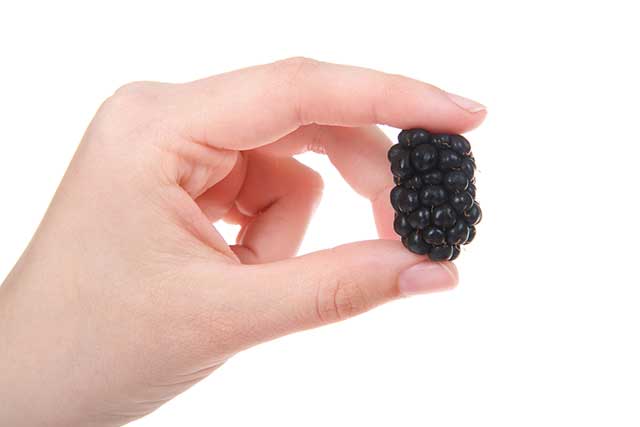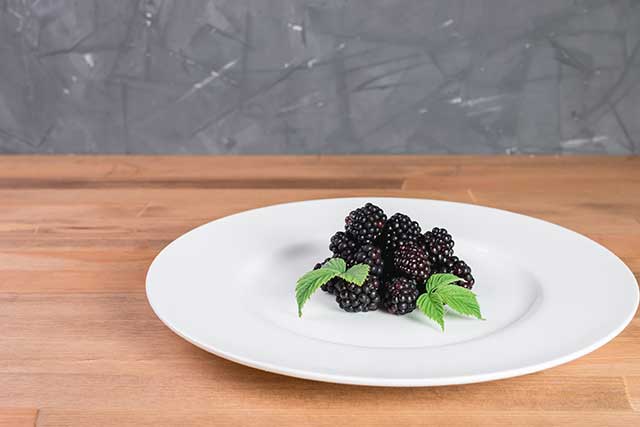Boysenberries 101: Nutrition Facts and Health Benefits
Boysenberries are a large berry with a sweet and slightly tart taste.
The boysenberry is a hybrid fruit, and it is a cross between several different types of berries.
In this article, we will examine what boysenberries are and their potential nutritional benefits.
What Are Boysenberries?
Boysenberries (Rubus ursinus) were first grown in California in 1923 by a horticulturist named Rudolf Boysen. The berries were named after their grower, hence the name “Boysen” berries (1).
These berries are not an original species, and they are a cross-breed of the following berries;
- European blackberries
- European raspberries
- American dewberries
- American loganberries
Boysenberries are quite large, and they reach a weight of approximately eight grams per berry. Depending on the stage of growth/ripeness, the berry’s color can vary between shades of green, pink, red, purple, and black (2).
Taste
The exact taste is hard to describe, and like any fruit, boysenberries have their own unique flavor.
However, the taste is reminiscent of blackberries and raspberries. Overall, the berries are sweet with a slight tartness.
Due to their size and (88%) water content, the berries are also very juicy compared to smaller berry species.
Nutrition Facts
Based on data from the NCC Food and Nutrient Database, the following tables show the nutritional values for boysenberries per 100-gram serving.
| Calories/Nutrient | Amount |
|---|---|
| Calories | 43 kcal |
| Carbohydrate | 9.61 g |
| Fiber | 5.30 g |
| Sugar | 4.31 g |
| Fat | 0.49 g |
| Saturated Fat | 0.01 g |
| Monounsaturated Fat | 0.05 g |
| Polyunsaturated Fat | 0.28 g |
| Omega-3 Fatty Acids | 0.09 g |
| Omega-6 Fatty Acids | 0.19 g |
| Protein | 1.39 g |
| Vitamin | Amount | % DV |
|---|---|---|
| Vitamin C | 21.0 mg | 35.0 % |
| Vitamin K | 19.8 mcg | 24.8 % |
| Vitamin E | 1.43 mg | 7.1 % |
| Folate | 25.0 mcg | 6.3 % |
| Niacin (B3) | 0.65 mg | 3.2 % |
| Pantothenic acid (B5) | 0.28 mg | 2.8 % |
| Riboflavin (B2) | 0.03 mg | 1.5 % |
| Pyridoxine (B6) | 0.03 mg | 1.5 % |
| Thiamin (B1) | 0.02 mg | 1.3 % |
| Choline | 8.50 mg | 1.5 % |
| Vitamin A | 10.7 mcg RAE | 1.2 % |
| Mineral | Amount | % DV |
|---|---|---|
| Manganese | 0.65 mg | 32.3 % |
| Copper | 0.17 mg | 8.3 % |
| Magnesium | 20.0 mg | 5.0 % |
| Potassium | 162.0 mg | 4.6 % |
| Zinc | 0.53 mg | 3.5 % |
| Iron | 0.62 mg | 3.4 % |
| Calcium | 29.0 mg | 2.9 % |
| Phosphorus | 22.0 mg | 2.2 % |
| Selenium | 0.40 mcg | 0.6 % |
| Sodium | 1.0 mg | <0.1 % |
As shown in the nutrition profile, boysenberries are primarily a source of carbohydrate – over half of which is from fiber.
The berries contain a reasonably wide range of nutrients.
Health Benefits of Boysenberries
Boysenberries may have several health benefits through their nutrient content and other bioactive compounds they contain.
1) Rich Source of Vitamin C
First of all, boysenberries are a good source of vitamin C, and they contain 35% of the recommended daily intake per 100 grams.
Vitamin C is an essential nutrient that has antioxidant properties and plays a crucial role in the immune system (3).
Studies also show that maintaining sufficient vitamin C levels may help to protect against various chronic diseases (4, 5).
2) May Help To Lower Blood Pressure
Some limited research demonstrates that boysenberries may have blood pressure-lowering properties.
For example, a study in rats showed that pure boysenberry juice “can significantly lower” systolic and diastolic blood pressure (6).
Another study showed similar effects from supplementing rats with polyphenol extracts from boysenberries (7).
However, we should remember that results from animal studies do not necessarily mean the results would be the same in human trials.
That said, a small human intervention trial in this regard showed promising results. In this study, 180 ml of concentrated boysenberry juice for four weeks improved blood flow and slightly reduced systolic blood pressure (8).
That said, this was a very small study of six participants, and more extensive research is necessary to confirm these potential blood pressure benefits.
3) A Good Source of Vitamin K
Boysenberries offer a moderate amount of vitamin K1.
Per 100-gram serving, the berries provide around a quarter of the recommended daily intake.
On this topic, research demonstrates that vitamin K may have an important role in maintaining bone quality and cardiovascular health (9, 10).
However, as shown in the above references, vitamin K1 does not offer the same bioavailability as vitamin K2. The latter may provide more benefits for bone mass density and reducing cardiovascular risk (11, 12).
Aside from its potential role in cardiovascular and skeletal health, vitamin K1 plays a vital role in blood coagulation (13).
4) Boysenberries Are High In Fiber
Boysenberries offer a good source of dietary fiber, containing more than five grams per 100 g.
Since their fiber content represents 5.3 grams of their total carbohydrate (9.6 grams), boysenberries are also low in “net” carbs.
In other words; the amount of carbohydrate they contain which will digest into glucose is minimal.
For this reason, boysenberries are an excellent choice of fruit for anyone following a lower-carbohydrate way of eating.
Fiber has some benefits of its own, too.
Firstly, fiber helps to slow the digestion of carbohydrate. Therefore, the fiber content of a carbohydrate-containing meal can help to lower the blood-glucose response to the food (14, 15).
Secondly, some research suggests that fiber may improve the health of so-called “beneficial bacteria” living in our gut (16).
5) Boysenberries Are Rich In Polyphenols
Polyphenols are bioactive compounds found in varying proportions in plant foods.
While people often discuss the polyphenol content of blueberries, all berries offer high amounts of these compounds.
On this note, boysenberries contain significant concentrations of compounds called anthocyanins (17).
Once (wrongly) thought to act as direct antioxidants in the body, the true nature of polyphenols is still little understood.
Interestingly, research suggests that the compounds may exert their health benefits through cell signaling and interacting with various biological pathways (18, 19).
Regarding the specific polyphenols in boysenberries, studies show that these compounds may;
- Suppress elevated triglyceride levels (20)
- Inhibit endothelial disorders and improve vascular health (21).
However, it is important to note these two studies were animal and cell culture studies. In other words; they cannot prove these effects would be the same within the human body.
As with all research on polyphenols, more long-term human studies are necessary to ascertain their (potential) benefits accurately.
Potential Concerns and Drawbacks
As with any food, there are some potential drawbacks of boysenberries.
1) Boysenberries Are High In Salicylates
Boysenberries contain high concentrations of salicylates, which are a type of anti-nutrient found in certain plant foods. The role of salicylates is to protect the plant against disease, infection, and pests (22, 23).
While salicylates are not a problem for the vast majority of people, some individuals are sensitive to them.
For instance, an estimated 2.5% of people within the EU have salicylate intolerance (24).
The various symptoms of salicylate intolerance may include;
- Bronchial asthma
- Rhinitis
- Intestinal inflammation
- Diarrhea
- General intestinal/skin complaints
Boysenberries are not suitable for a low-salicylate diet.
As always with any medical concern, individuals who suspect they may have a salicylate intolerance should discuss this with their doctor.
2) Canned Boysenberries Are High In Sugar
The three most typical forms of boysenberries that we can buy are;
- Fresh
- Frozen
- Canned
The first two of these options are simply pure boysenberries with no additives. However, canned boysenberries contain large amounts of added sugar.
To illustrate this; boysenberries canned in heavy syrup contain 22.3 grams of carbohydrate per 100 grams, most of which is added sugar (25).
In contrast, an equivalent amount of fresh berries contains only four grams of sugar.
How To Use Boysenberries
For those unsure of what to do with boysenberries, there are many different ways in which we can use them.
Here are a few ways to eat them.
As a Snack
Boysenberries have a delicious flavor, and they don’t need any additional ingredients to taste good.
A handful of these berries is an easy and healthy snack. To include some fats and protein, try eating them alongside your favorite nuts.
As a Dessert
The simple way to make any form of berries taste better is to combine them with some heavy cream.
Cream and berries is a classic combination that makes a perfect and reasonably healthy dessert.
As a Healthier Smoothie Option
Many people enjoy drinking smoothies.
However, the vast majority of commercially available options are full of added sugars. In other words; it is far better to make your own.
For a tasty and thick option that includes boysenberries, try these ingredients;
- 1 cup (240 ml) of plain yogurt
- 2 oz (57 g) boysenberries
- 2 oz (57 g) blueberries
- 1 fl oz (28 ml) heavy cream
- Several ice cubes
For Making Jam
Almost every berry makes a good jam, and boysenberry jams are a traditional and popular option.
There are many recipes available online, and it is easy to make a healthier, sugar-free version using sweeteners such as erythritol.
Final Thoughts
Boysenberries are one of the best-tasting berries out there. These berries are big, juicy, and they have a delicious taste.
As a bonus, boysenberries provide a decent range of nutrients for very few calories, and they are also one of the lowest sugar fruits.
For more on berries, see this guide to what goji berries offer.


